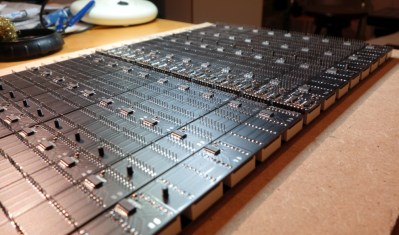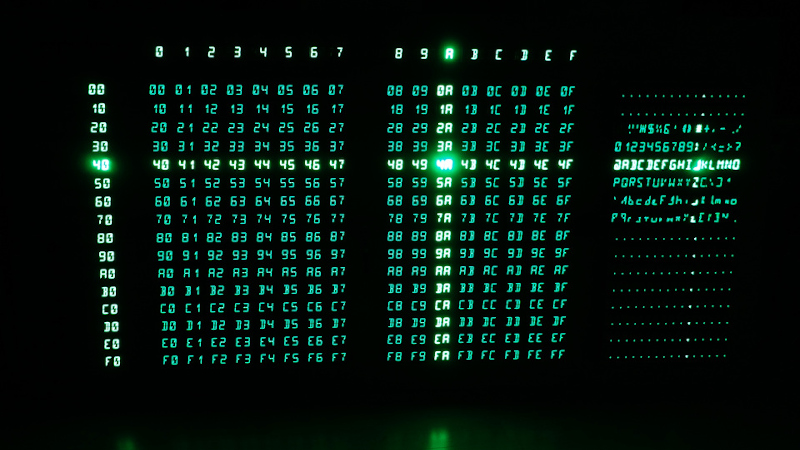Over the years, the media has managed to throw together some pretty ridiculous visual depictions of computer hacking. But perhaps none have gone as far down the road of obfuscation as The Matrix, where the most experienced hackers are able to extract information from a display of cascading green glyphs like a cyberpunk version of reading tea leaves. It’s absolutely ridiculous, with zero basis in reality.
Well, maybe not anymore. Taking a page from these outlandish visions of hacking, [Erik Bosman] has constructed a dedicated hex dump display out of fourteen segment alphanumeric LEDs that looks like it could be pulled from a movie set. But make no mistake, it’s more than just a pretty face. By cleverly varying the brightness of the individual characters, he’s managed to make his so-called “hexboard” completely usable despite the fact that everything’s the same color.
 While he says the project is not quite at 100% yet, he’s already released the firmware, computer-side software, and even the PCB design files for anyone who might want to build their own version. Though as you might imagine, it’s quite a tall order.
While he says the project is not quite at 100% yet, he’s already released the firmware, computer-side software, and even the PCB design files for anyone who might want to build their own version. Though as you might imagine, it’s quite a tall order.
The display is broken up into segments holding eight Houkem-5421 LED modules apiece, each with its own STM32F030F4 and two TC7258E LED controllers. The bill of materials on this one is a bit intimidating, but when the end result look this good it’s hard to complain.
To build a somewhat smaller version that also features a more retro vibe, you might consider doing something similar by chaining together vintage LED “bubble” displays.
















His example video on twitter (https://twitter.com/brainsmoke/status/1207409708694474753) shows a cool animation using the board.
– Wow – yes, need that in the article, the video makes this 100x more awesome than the above still does.
super cool job
I clicked on this article specifically looking for the link that you provided. The article should be amended as that animation is infinitely cooler than the one posted.
Matrix…well….and Ghost in the shell
Impressive. A part of me wants to build it, part of me remembers the multi-day debugging sessions with nothing but a row of wheat-bulb indicators with switches under them with mixed feelings, and the last part of me says “NO! Too much time and money”
Phew, looks absolutely gorgeous but think of how much current the whole thing sucks!
Individually controlling the brightness of each segment is something you need to see in video form: https://twitter.com/brainsmoke/status/1207409708694474753
That is awesome.
“But perhaps none have gone as far down the road of obfuscation as The Matrix, where the most experienced hackers are able to extract information from a display of cascading green glyphs like a cyberpunk version of reading tea leaves. It’s absolutely ridiculous, with zero basis in reality.”
And sentient computer programs do?
I thought someone had gone down this route – ie microsoft? How about visual studio?
“…none have gone as far down the road of obfuscation as The Matrix, where the most experienced hackers are able to extract information from a display of cascading green glyphs like a cyberpunk version of reading tea leaves.”
That’s not an impossible scenario, though. I remember watching, then emulating, a friend looking at a raw tcpdump of their home network to figure out the IP address of a misbehaving machine that was saturating the network. I actually made the “blonde, brunette, redhead” joke about the data as he would watch it for a while, stop it and make some change to things, and then go back to staring at the dump as it scrolled past. Eventually, I found the “sweet spot”.
He was letting his eyes relax while pointed at a specific spot on the screen and watching the IP address of the machines fly by. His gaze rested on a single spot that would appear to flicker between multiple IP addresses rather than trying to read a single line as it scrolled upward. The pauses were to eliminate machines whose address he knew.
Eventually, only one machine was appearing often enough to be read, the others flicking by fast enough to appear as glitches below the threshold of visual acquisition. It was like a flicker on a screen where you’re reading text, they were there and gone too quickly to interrupt what one was doing.
It was, pardoning the phrasing, an enlightening experience about using things the brain is good at to further filter chaotic-seeming data. It also caused me to re-evaluate the scene itself. Yes, weird poly-alphabetical glyphs are bullshit, but it turns out that reading a chaotic field of data is just barely possible.
Sure… Kinda. I used to do that too. I did it in the dorms my Freshman year of college. Back then there was so much less encryption. You could even see the email and instant messenger passwords although I pretty much ignored those. Mostly I just looked at the “educational site” URLs in the http request headers. (no need to bother with ips when hardly anything was https yet) Who knew that everyone in the building was a biology major? LOL In the summer after that they upgraded from hubs to switches so there was no longer anything interesting to dump.
Anyway.. grabbing addresses from a raw stream… sure. Actually perceiving the blonde in the Matrix in such a way that there is something to get excited about? No way!
Still.. I like plausibility in my sci-fi so I told myself that the machines had somehow changed the brains of the humans. Perhaps it was to make them more compatible with the Matrix. Seeing things in the raw data stream was a side effect. Then came the sequel, Neo waved his hand in [supposedly] the real world and the sentinels shut down. Damn you Wachowski Brothers!
One of the main things that makes the Matrix code display ridiculous is that there’s no way to learn what they were doing. You can’t be in the Matrix and looking at that code at the same time, so how would you learn to correlate codes to “stuff”? An analogy would be trying to learn a foreign language by watching TV with subtitles, but only having the subtitles with no audio or video.
Weren’t they often watching their teammates operate inside the matrix at the same time, though?
Yes and no. They could only decode images inside the training programs like the dojo. This was likely done to prevent omniscience of the Operator, which would prevent a lot of key surprises plot-wise. A quote from the first film, when Neo “scares the bejesus” out of Cipher likely setting up his meeting with Smith before he quickly closes everything but the code displays:
Neo: Do you always look at it encoded?
Cypher: Well you have to. The image translators work for the construct program. But there’s way too much information to decode the Matrix. You get used to it. I…I don’t even see the code. All I see is blonde, brunette, red-head…
They were watching unconscious people in dentist chairs, and that code waterfall. They didn’t have video of them in the matrix to compare to the code.
They did seem to have access to 3D models of buildings and things, so I guess they had developed software that could parse the code, which could explain the ability of some to decipher it by eye, I guess…
A smaller version:
https://hackaday.io/project/163549-a-seven-segment-art-installation
I just calculated cost of this if I wanted to make it. Well, it would take five weeks of my family’s income to buy 944 14-segment displays alone…
Maybe it’s possible to find them significantly cheaper because you buy a thousand? There still remains a problem of pcbs and the controllers, but those can be price reduced neatly because most manufacturers will make no less than 10 boards anyway.
Does anyone know of a write-up anywhere on how to recreate this?